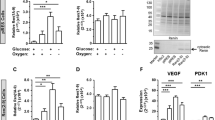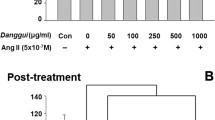Abstract
The (pro)renin receptor is a new molecular member of the renin–angiotensin system and participates in regulating many physiological and pathological processes. However, the role of (pro)renin receptor-mediated signaling pathways in myocardial ischemic/reperfusion injury remains unclear. In this study, we hypothesized that p38 mitogen-activated protein kinase (MAPK) signaling pathway activation by the (pro)renin receptor had effects on myocardial apoptosis induced by ischemia/reperfusion. This analysis was performed using a hypoxia/reoxygenation model in H9c2 cells to mimic ischemia/reperfusion injury. The H9c2 rat cardiomyocyte cell line was subjected to 2 h of hypoxia followed by 6 h of reoxygenation. The (pro)renin receptor, caspase 3, and phosphorylated p38 MAPK protein expression levels were analyzed by Western blot. After 2 h of hypoxia followed by 6 h of reoxygenation, apoptosis increased in H9c2 cells; the (pro)renin receptor, caspase 3, and phosphorylated p38 MAPK protein expressions were upregulated. siRNA silencing of the (pro)renin receptor significantly decreased p38 MAPK phosphorylation. siRNA silencing of the (pro)renin receptor and treatment with the p38MAPK inhibitor SB203580 significantly decreased the hypoxia/reoxygenation-induced apoptosis and caspase 3 protein expression in H9c2 cells. Furthermore, we found that the role of the (pro)renin receptor was independent of angiotensin II (Ang II). Thus, we concluded that (pro)renin receptor activation could trigger hypoxia/reoxygenation-induced apoptosis in H9c2 cells, partially through the p38 MAPK/caspase 3 signaling pathway, independent of Ang II. Therefore, this study may provide new therapeutic targets for myocardial ischemic/reperfusion injury prevention, and further in vivo studies are needed.






Similar content being viewed by others
References
Zhu B, Sun Y, Sievers RE, Browne AE, Pulukurthy S, Sudhir K, Lee RJ, Chou TM, Chatterjee K, Parmley WW (2000) Comparative effects of pretreatment with captopril and losartan on cardiovascular protection in a rat model of ischemia-reperfusion. J Am Coll Cardiol 35:787–795
Yahiro E, Ideishi M, Wang LX, Urata H, Kumagai K, Arakawa K, Saku K (2003) Reperfusion-induced arrhythmias are suppressed by inhibition of the angiotensin II type 1 receptor. Cardiology 99:61–67
Dogan R, Farsak B, Isbir S, Sarigul A, Tuncer M, Kilinc K (2001) Protective effect of lisinopril against ischemia-reperfusion injury in isolated guinea pig hearts. J Cardiovasc Surg (Torino) 42:43–48
Huang J, Siragy HM (2009) Glucose promotes the production of interleukine-1beta and cyclooxygenase-2 in mesangial cells via enhanced (Pro)renin receptor expression. Endocrinology 150:5557–5565
Huang Y, Wongamorntham S, Kasting J, McQuillan D, Owens RT, Yu L, Noble NA, Border W (2006) Renin increases mesangial cell transforming growth factor-beta1 and matrix proteins through receptor-mediated, angiotensin II-independent mechanisms. Kidney Int 69:105–113
Saris JJ, t Hoen PA, Garrelds IM, Dekkers DH, den Dunnen JT, Lamers JM, Jan Danser AH (2006) Prorenin induces intracellular signaling in cardiomyocytes independently of angiotensin II. Hypertension 48:564–571
Susic D, Zhou X, Frohlich ED, Lippton H, Knight M (2008) Cardiovascular effects of prorenin blockade in genetically spontaneously hypertensive rats on normal and high-salt diet. Am J Physiol Heart Circ Physiol 295:H1117–H1121
Ichihara A, Kaneshiro Y, Takemitsu T, Sakoda M, Suzuki F, Nakagawa T, Nishiyama A, Inagami T, Hayashi M (2006) Nonproteolytic activation of prorenin contributes to development of cardiac fibrosis in genetic hypertension. Hypertension 47:894–900
Takahashi H, Ichihara A, Kaneshiro Y, Inomata K, Sakoda M, Takemitsu T, Nishiyama A, Itoh H (2007) Regression of nephropathy developed in diabetes by (Pro)renin receptor blockade. J Am Soc Nephrol 18:2054–2061
Kinouchi K, Ichihara A, Sano M, Sun-Wada GH, Wada Y, Kurauchi-Mito A, Bokuda K, Narita T, Oshima Y, Sakoda M, Tamai Y, Sato H, Fukuda K, Itoh H (2010) The (pro)renin receptor/ATP6AP2 is essential for vacuolar H+-ATPase assembly in murine cardiomyocytes. Circ Res 107:30–34
Bernhard SM, Seidel K, Schmitz J, Klare S, Kirsch S, Schrezenmeier E, Zaade D, Meyborg H, Goldin-Lang P, Stawowy P, Zollmann FS, Unger T, Funke-Kaiser H (2012) The (pro)renin receptor ((P)RR) can act as a repressor of Wnt signalling. Biochem Pharmacol 84:1643–1650
Li DY, Tao L, Liu H, Christopher TA, Lopez BL, Ma XL (2006) Role of ERK1/2 in the anti-apoptotic and cardioprotective effects of nitric oxide after myocardial ischemia and reperfusion. Apoptosis 11:923–930
Engelbrecht AM, Niesler C, Page C, Lochner A (2004) p38 and JNK have distinct regulatory functions on the development of apoptosis during simulated ischaemia and reperfusion in neonatal cardiomyocytes. Basic Res Cardiol 99:338–350
Ferrandi C, Ballerio R, Gaillard P, Giachetti C, Carboni S, Vitte PA, Gotteland JP, Cirillo R (2004) Inhibition of c-Jun N-terminal kinase decreases cardiomyocyte apoptosis and infarct size after myocardial ischemia and reperfusion in anaesthetized rats. Br J Pharmacol 142:953–960
Porter AG, Janicke RU (1999) Emerging roles of caspase-3 in apoptosis. Cell Death Differ 6:99–104
Saikumar P, Dong Z, Mikhailov V, Denton M, Weinberg JM, Venkatachalam MA (1999) Apoptosis: definition, mechanisms, and relevance to disease. Am J Med 107:489–506
Liu FY, Liu XY, Zhang LJ, Cheng YP, Jiang YN (2014) Binding of prorenin to (pro)renin receptor induces the proliferation of human umbilical artery smooth muscle cells via ROS generation and ERK1/2 activation. J Renin Angiotensin Aldosterone Syst 15:99–108
Liao H, Gong J, Zhang W, Guo X (2012) Valsartan inhibits angiotensin II-induced proliferation of vascular smooth muscle cells via regulating the expression of mitofusin 2. J Huazhong Univ Sci Technol Med Sci 32:31–35
Feldt S, Batenburg WW, Mazak I, Maschke U, Wellner M, Kvakan H, Dechend R, Fiebeler A, Burckle C, Contrepas A, Jan Danser AH, Bader M, Nguyen G, Luft FC, Muller DN (2008) Prorenin and renin-induced extracellular signal-regulated kinase 1/2 activation in monocytes is not blocked by aliskiren or the handle-region peptide. Hypertension 51:682–688
Nguyen G, Delarue F, Burckle C, Bouzhir L, Giller T, Sraer JD (2002) Pivotal role of the renin/prorenin receptor in angiotensin II production and cellular responses to renin. J Clin Investig 109:1417–1427
Mahmud H, Candido WM, van Genne L, Vreeswijk-Baudoin I, Yu H, van de Sluis B, van Deursen J, van Gilst WH, Sillje HH, de Boer RA (2014) Cardiac function and architecture are maintained in a model of cardio restricted overexpression of the prorenin-renin receptor. PLoS One 9:e89929
Fernandes-Alnemri T, Litwack G, Alnemri ES (1994) CPP32, a novel human apoptotic protein with homology to Caenorhabditis elegans cell death protein Ced-3 and mammalian interleukin-1 beta-converting enzyme. J Biol Chem 269:30761–30764
Salvesen GS (2002) Caspases: opening the boxes and interpreting the arrows. Cell Death Differ 9:3–5
Ghavami S, Hashemi M, Ande SR, Yeganeh B, Xiao W, Eshraghi M, Bus CJ, Kadkhoda K, Wiechec E, Halayko AJ, Los M (2009) Apoptosis and cancer: mutations within caspase genes. J Med Genet 46:497–510
Yang B, Ye D, Wang Y (2013) Caspase-3 as a therapeutic target for heart failure. Expert Opin Ther Targets 17:255–263
Black SC, Huang JQ, Rezaiefar P, Radinovic S, Eberhart A, Nicholson DW, Rodger IW (1998) Co-localization of the cysteine protease caspase-3 with apoptotic myocytes after in vivo myocardial ischemia and reperfusion in the rat. J Mol Cell Cardiol 30:733–742
Mandlekar S, Kong AN (2001) Mechanisms of tamoxifen-induced apoptosis. Apoptosis 6:469–477
Yu G, Peng T, Feng Q, Tyml K (2007) Abrupt reoxygenation of microvascular endothelial cells after hypoxia activates ERK1/2 and JNK1, leading to NADPH oxidase-dependent oxidant production. Microcirculation 14:125–136
Liu AL, Wang XW, Liu AH, Su XW, Jiang WJ, Qiu PX, Yan GM (2009) JNK and p38 were involved in hypoxia and reoxygenation-induced apoptosis of cultured rat cerebellar granule neurons. Exp Toxicol Pathol 61:137–143
Shimada K, Nakamura M, Ishida E, Kishi M, Konishi N (2003) Roles of p38- and c-jun NH2-terminal kinase-mediated pathways in 2-methoxyestradiol-induced p53 induction and apoptosis. Carcinogenesis 24:1067–1075
Sakoda M, Ichihara A, Kaneshiro Y, Takemitsu T, Nakazato Y, Nabi AH, Nakagawa T, Suzuki F, Inagami T, Itoh H (2007) (Pro)renin receptor-mediated activation of mitogen-activated protein kinases in human vascular smooth muscle cells. Hypertens Res 30:1139–1146
Liu FY, Liu XY, Zhang LJ, Cheng YP, Jiang YN (2014) Binding of prorenin to (pro)renin receptor induces the proliferation of human umbilical artery smooth muscle cells via ROS generation and ERK1/2 activation. J. Renin Angiotensin Aldosterone Syst 15:99–108
Conflict of interest
The authors have no conflicts of interest to declare.
Funding
This work was supported by the National Natural Science Foundation of China (No. 3027143).
Author information
Authors and Affiliations
Corresponding author
Rights and permissions
About this article
Cite this article
Liu, Y., Zhang, S., Su, D. et al. Inhibiting (pro)renin receptor-mediated p38 MAPK signaling decreases hypoxia/reoxygenation-induced apoptosis in H9c2 cells. Mol Cell Biochem 403, 267–276 (2015). https://doi.org/10.1007/s11010-015-2356-8
Received:
Accepted:
Published:
Issue Date:
DOI: https://doi.org/10.1007/s11010-015-2356-8




